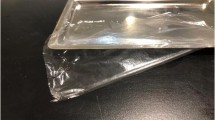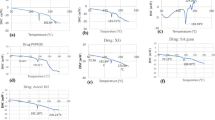Abstract
An erodible gastric retention device fabricated from various polymeric blends was examined in vitro for its dissolution properties and in vivo in fasting dogs for assessment of its gastric retention potential. Dissolution studies were conducted with extruded rods of polymer blends to assess their potential as candidates for the erodible component of a gastrically retained device. Based on results from dissolution studies, rods of poly(ortho ester)/polyethylene blends (POE/PE) (45% erosion at pH 1.5 and 24 hr) were used to fabricate arms for tetrahedron-shaped devices. Corners for the tetrahedral device were fabricated from Silastic 382 loaded with 15% barium sulfate for X-ray visualization. Beagle dogs were dosed with tetrahedron-shaped test devices administered in gelatin capsules and gastric retention monitored by X ray over a 24-hr period. A comparison of in vitro erosion rates and in vivo performance of various polymer blends indicated a definite trend for increased gastric retention of devices made from the more slowly eroding blends. The results indicate that the blending of erodible and nonerodible polymers is a valid approach for obtaining materials that will provide the necessary structural properties to achieve gastric retention yet lose integrity within a desired time.
Similar content being viewed by others
REFERENCES
C. Gardner. In R. Borchardt, A. Repta, and V. Stella (eds.), Directed Drug Delivery, Humana Press, Clifton, N.J., 1985, pp. 61–82.
S. S. Davis. In R. Borchardt, A. Repta, and V. Stella (eds.), Directed Drug Delivery, Humana Press, Clifton, N.J., 1985, pp. 319–340.
R. Cargill, L. Caldwell, K. Engle, J. A. Fix, P. A. Porter, and C. R. Gardner. Pharm Res. (in press).
ASTM. ASTM D 790 (Vol. 8.01), Annual Book of ASTM Standards, Philadelphia, Pa., 1987.
J. Heller. Biomaterials 1:51–57 (1980).
R. V. Sparer, C. Shih, C. D. Ringeisen, and K. S. Himmelstein. J. Cont. Rel. 1:23–32 (1984).
Author information
Authors and Affiliations
Rights and permissions
About this article
Cite this article
Cargill, R., Engle, K., Gardner, C.R. et al. Controlled Gastric Emptying. II. In Vitro Erosion and Gastric Residence Times of an Erodible Device in Beagle Dogs. Pharm Res 6, 506–509 (1989). https://doi.org/10.1023/A:1015976709043
Issue Date:
DOI: https://doi.org/10.1023/A:1015976709043




